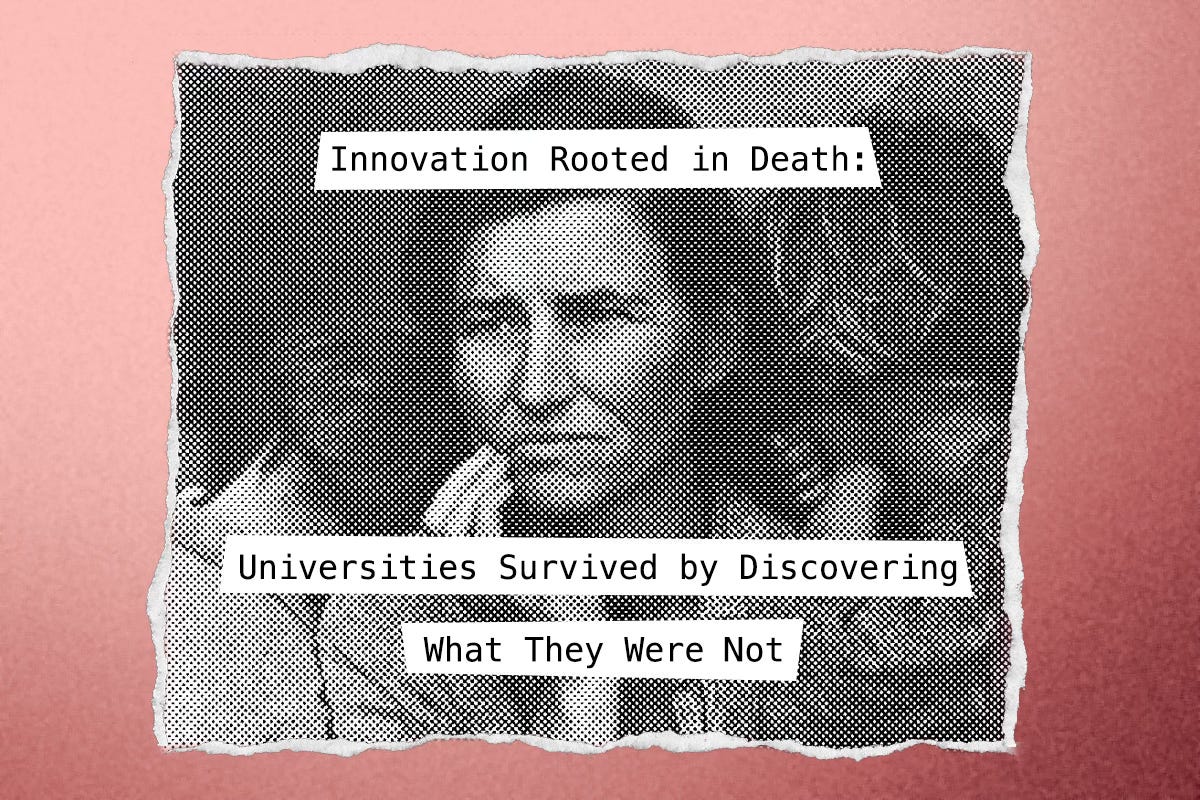Innovation Rooted in Death: Universities Survived by Discovering What They Were Not
For some universities, the courage to innovate came from their organizational near-death experience.
Note: Today’s guest post comes from Joshua Travis Brown, Assistant Professor at The Johns Hopkins University. He is the author of Capitalizing on College, which examines how tuition-dependent universities operate, struggle, and adapt within the market-driven realities of higher education. You can also find more of his writing at The Leading Edge. -Ryan Allen
“This place was on its deathbed,” explained one president. An administrator at another college admitted, “We had a closing plan here,” while a senior leader elsewhere candidly told me, “It was ‘going out of business’ time.”
All across the country, college and university leaders I talked to while writing Capitalizing on College had vivid memories of when their institutions should have died.
Whether from increasing competition, investment losses, education policy changes, financial mismanagement, or pandemics, institutions within America’s higher education system have faced constant existential threats. These challenges have forced administrators to make difficult decisions—not least of which being whether to close or embrace significant change.
Uncovering the Unexpected
When I visited eight different universities each for a week to interview leaders about their stories of innovation, I stumbled across the unexpected. I asked university leaders to tell me about innovative practices on their campuses, and many replied with a similar narrative that directed me back in time. Some leaders took me back to moments 10 years earlier and others 30 years earlier. They made it plain to me that the innovative practices of today were rooted in the courage of yesteryear they found in an organizational near-death experience.
“That summer I missed two paychecks,” one administrator candidly recalled, while a faculty colleague shared the shocking uncertainty her family experienced: “I was nine months pregnant… I remember where we were living and thinking we’re not going to make it this month, we cannot pay our house payment.” Summing up the precariousness of the era, the president of their school admitted that “[we were] really just on the edge of survival.” Or as one historical volume about the university succinctly stated, “Failure seemed imminent.”
But on the brink of institutional death, rather than succumbing to seemingly inevitable closure, the school’s founder described in his autobiography how their school found the courage “to completely change the business model.” Describing this shift that ultimately saved the school, one board member explained how “the founder decided to embrace the more radical, more aggressive, less safe method, and it worked… We actually got traction. We actually got cash flow.” The most successful period of innovation for their school had been found only after staring death in the face.
Not Keeping Up with the Joneses
Time and again, the leaders of the various entrepreneurial schools in Capitalizing on College stressed to me the organizational near-death moment was vital because it provided them with the motivation necessary to stop emulating the traditional “best practices” maintained by elite schools. In American higher education, the disproportionate focus on a small number of elite colleges and universities creates a powerful social norm - an impetus for other schools to attempt to emulate the traditional “best practices” of these elite schools in an effort to “keep up with the Joneses” and even aspire to break into that upper echelon of institutions. When faced with death, these leaders took stock and decided changes needed to be made, the foremost of which was to eschew the elites.
Explaining the deficiencies in the elite approach, one senior leader told me “Exclusivity is only working as a business model for a very tiny minority of institutions. But there are literally hundreds attempting to practice that business model to their eventual demise.” Grateful their near-death story hadn’t ended in demise; he proudly asserted that now, “One of the key differences for [our school] is we don’t practice that business model at all.”
One vice president I spoke with explained how their school barely escaped an institutional death spiral caused by modeling fundraising efforts on traditional practices of elites. Admitting that this approach had nearly shuttered their institution, he described learning the lesson to not mimic elite institutions, but rather to reject that approach entirely: “Higher education culture seeps into everybody but us.”
Similarly, a finance executive at another university described how they broke out of the traditional model espoused by elites and found their innovative breakthrough at the brink of death:
We realized… that growth is through programs. And you don’t have to grow a program every year, but if you don’t do one every two to three years... you’re going to start dying. You’ve got to keep moving on the tracks. You’ve got to keep moving. If you stop, you go backwards.
As enticing as it might seem to emulate the schools at the top of the rankings, the prevailing theme at each tuition-driven school I visited was that tying yourself to the traditional model meant facing death, while eschewing the elites in favor of innovation was a chance for new life.
Pushing Past the Stigma
A second important facet of the near-death stories these organizational leaders conveyed, was the high degree of social stigmatization they faced following their decision to eschew the powerful elite norms that guide higher education. The ostracism administrators faced for bucking traditional norms was intense, with some elites even chastising these innovative schools for eroding the quality of higher education more broadly, “Everybody was basically calling us a degree mill and all different kinds of names about what we were doing to higher education.” Another senior leader shared, “We were early engagers of adult learners, even when the rigor and legitimacy of that was questioned in the academy.”
Even thirty years after the events had originally transpired, I watched one president grimace as he thought back to when his predecessor fought to pull the university back from the brink of death by embracing innovation:
He paid a huge personal price… for defending and protecting the adult programs at a time when that was so strange and new that everybody didn’t think it was legitimate. And because it was growing, he would never go to professional meetings... because he got hammered... Presidents would say ‘What are you doing in my community? Why are you here? Are you trying to put me out of business?’
But in the face of stigmatization, the leaders at these schools recognized that the alternative was far worse. As one school executive made clear, breaking with tradition involves risk and while innovation might hold the key to institutional survival, it’s not for the faint of heart: “You’ve got to be willing to stand up, you’ve got to be willing to lose your job.” Another leader stressed they did something not everyone can do by embracing the stigma associated with innovation and change: “A lot of institutions cannot do that…for some of them it’s so painful that they would just soon die than really change.”
For these schools, the weight of financial uncertainty eclipsed concerns of social stigma that came with the innovative pursuit of resources needed to save its existence. Faced with the choice of leading either a stigmatized or a shuttered institution, these leaders opted for the former.
Adapt or Die
“Either you adapt or die off,” one vice president stated while pantomiming a guillotine motion.
So, how do you pull back from the brink? For the schools I visited, it took a near death experience for leaders to see the light of innovation. Fortunately for them, and for us, near death doesn't always have to lead to death and innovation can come in many forms.
Breaking from tradition and embracing innovation in the face of death is likely going to result in criticism. But in a fight for your life, you have to remember your mission. The question that remains for American higher education is which schools will succumb to death, and which will use the occasion to find courage, innovation, and new life.
Note: You can read more from Joshua Travis Brown at The Leading Edge and in the book Capitalizing on College. If you are interested in writing for College Towns, feel free to reach out to me on Substack or at ryanmallen555@gmail.com.








This article says nothing concrete about the traditional college model or how administrators move beyond it. Is it written by chatGPT?